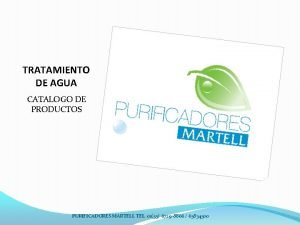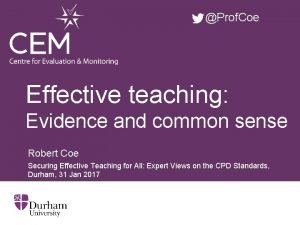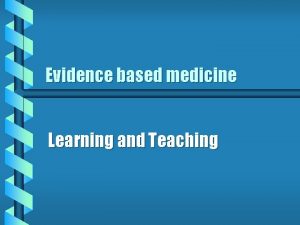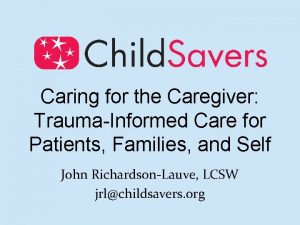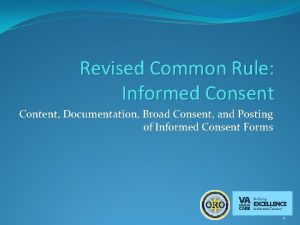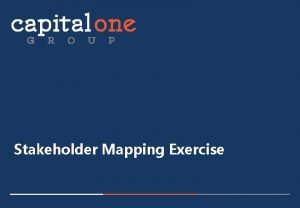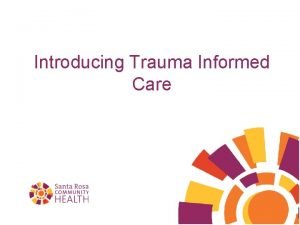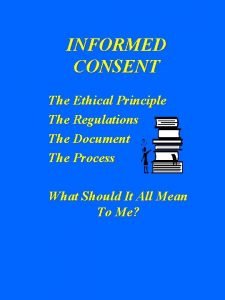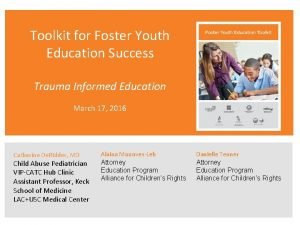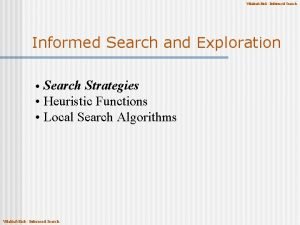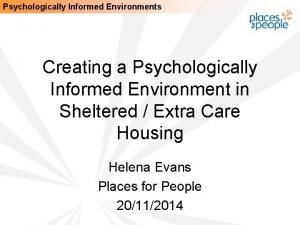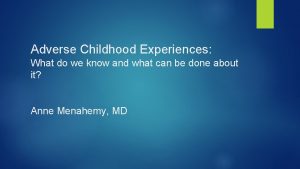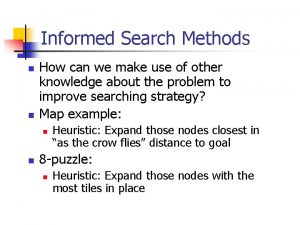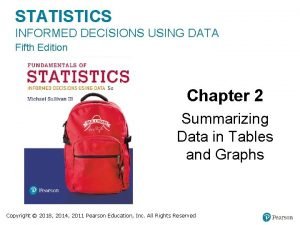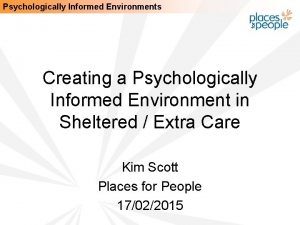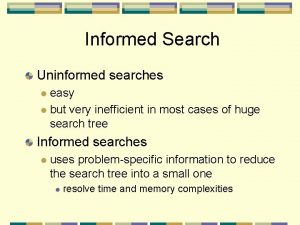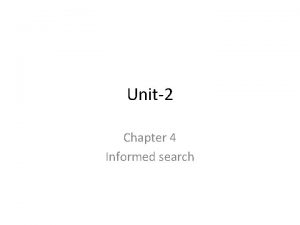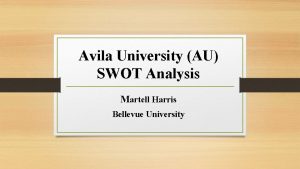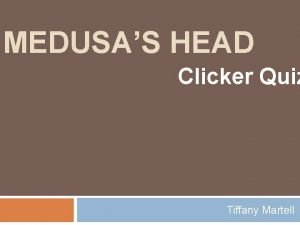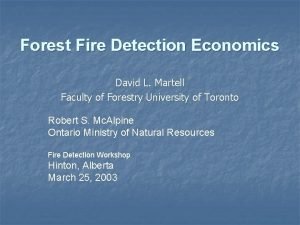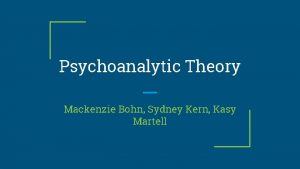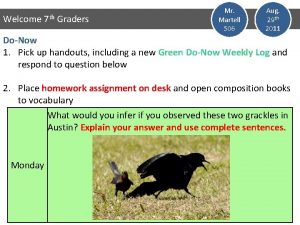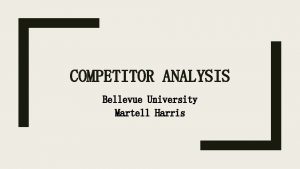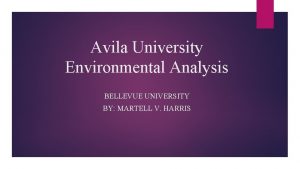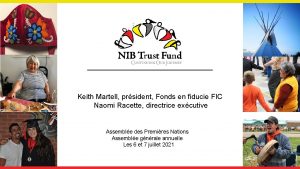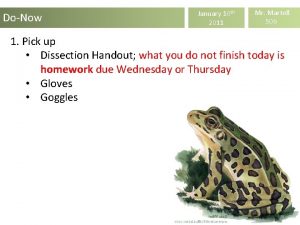Evidence informed literacy teaching Thomas Martell Literacy Matters















































- Slides: 47

Evidence informed literacy teaching Thomas Martell Literacy Matters, Wiltshire Wednesday 14 th November 2018 @Educ. Endow. Foundn

About the EEF Independent charity dedicated to breaking the link between family income and educational achievement We aim to raise the attainment of 3 -18 year-olds, particularly those facing disadvantage; develop their essential life skills; and prepare young people for the world of work and further study. Evidence as a lever for change • Focus effort • Get the most out of limited resources • Resist fads and fakes @Educ. Endow. Foundn

Disadvantaged pupils start and stay behind @Educ. Endow. Foundn Source: EEF (2018) The Attainment Gap

Which would you choose? Project A • A reading initiative that aimed to increase a child’s motivation to read. • Weekly 1 -hour sessions where pupils read and discussed an ageappropriate book. • Delivered by trained graduates to pupils who had not achieved expected level at the end of primary school. Project B • A whole-group programme that aims to foster the habit of independent reading. • Online system measures pupils’ reading levels, and suggests books that match their reading age and interests. • Pupils take computerised quizzes on the books they have read and earn ‘points’ related to difficulty. Group Months progress All pupils -2 months All pupils +3 months FSM-eligible -4 months FSM-eligible +5 months @Educ. Endow. Foundn

Evidence-informed teaching Context Professional judgement @Educ. Endow. Foundn High-quality evidence

Put these in order from biggest to smallest impact Small group tuition Feedback +7 Digital technology One-to-one tuition +5 School uniform Small group tuition +4 Repeating a year Digital technology +4 One-to-one tuition Learning styles +2 Learning styles School uniform 0 Feedback Repeating a year -4 @Educ. Endow. Foundn

Where to start? Wine Tomatoes Tea Milk Eggs Corn Coffee Butter Beef Protects against cancer @Educ. Endow. Foundn Causes cancer

Where to start? @Educ. Endow. Foundn

An accessible summary of research @Educ. Endow. Foundn

An accessible summary of research @Educ. Endow. Foundn

@Educ. Endow. Foundn Repeating a year Ability grouping School uniform Physical environment Performance pay Block scheduling Aspiration interventions Mentoring Homework (Primary) Teaching assistants Individualised instruction After school programmes Extended school time Learning styles Arts participation Sports participation Summer schools Reducing class size Outdoor adventure learning Parental involvement Social and emotional aspects of learning Digital technology Behaviour interventions Small group tuition Phonics Mastery learning Oral language interventions Collaborative learning One to one tuition Homework (Secondary) Early years intervention Peer tutoring Meta-cognition and self-regulation Feedback 0. 2 Effect size It’s the decisions within schools that matter most 0. 8 0. 6 0. 4 0 -0. 2 -0. 4

Value for money Promising 1. 0 Feedback Meta-cognition Could be worth it Effect Size Peer tutoring 1 -1 tutoring Homework (Secondary) Summer schools Phonics Parental involvement Digital technology Homework (Primary) 0 Performance pay £ 0 EY intervention Ability grouping @Educ. Endow. Foundn Cost per pupil Smaller classes Teaching assistants Needs careful thought £ 1000

Guidance reports @Educ. Endow. Foundn

Themes Efficient teaching Fluency of basic skills Explicit teaching Gradual release of responsibility from teacher to students It’s not just what you do, it’s the way that you do it @Educ. Endow. Foundn

Glasses Questions to consider Around 13% of children have an untreated vision problem • What screening services are commissioned in your local area? Important for health, wellbeing and education • What do you do to ensure all children with possible sensory needs are identified? Significantly more likely to affect children from disadvantaged backgrounds • What do you do to ensure children given glasses, or other treatments, use them? @Educ. Endow. Foundn

Speaking and listening @Educ. Endow. Foundn

Speaking and listening Intrinsic value Provides foundation for reading and writing Good modelling is vital Of course, everyone already does it… @Educ. Endow. Foundn

Speaking and listening Thinking, doing, talking science Aims to make science lessons more practical, creative and challenging. Teachers trained in a range of strategies that aim to encourage pupils to use higher order thinking skills. Philosophy for children Students participate in dialogue based around a concept, e. g. ‘truth’, ‘fairness’ or ’bullying’. Aims to encourage students to ask questions, construct arguments and engage in reasoned discussion. Dialogic teaching Aims to improve the quality of classroom talk. Teachers are trained in strategies that enable pupils to reason, discuss, argue and explain rather than merely respond. Outcome Months progress Science +3 Maths +2 Maths +1 Reading +2 @Educ. Endow. Foundn

When it’s done well Often looks effortless, but is very challenging Develops thinking skills Develops expressive and receptive vocabulary Can develop language comprehension Articulating ideas supports writing composition @Educ. Endow. Foundn

Reading @Educ. Endow. Foundn

Reading: key messages Use a balanced approach Explicitly teach reading comprehension strategies Develop children’s reading fluency Prioritise areas of need @Educ. Endow. Foundn

Decoding Simple View of Reading Good word recognition, poor comprehension Good word recognition, good comprehension Poor word recognition, poor comprehension Good comprehension, poor word recognition Language comprehension @Educ. Endow. Foundn

An extension of the simple view @Educ. Endow. Foundn Page 10 of KS 2 guidance

Reading fluency discussion What is reading fluency? Why does reading fluency matter? How can reading fluency be developed? @Educ. Endow. Foundn

1 2 3 4 Expression and volume Reads in a quiet voice as if to get words out. The reading does not sound natural like talking to a friend. Reads in a quiet voice. The reading sounds natural in part of the text, but the reader does not always sound like they are talking to a friend. Reads with volume and expression. However, sometimes the reader slips into expressionless reading and does not sound like they are talking to a friend. Reads with varied volume and expression. The reader sounds like they are talking to a friend with their voice matching the interpretation of the passage. Phrasing Reads word-by-word in a Reads in two or three monotone voice. word phrases, not adhering to punctuation, stress and intonation. Reads with a mixture of run-ons, mid-sentence pauses for breath, and some choppiness. There is reasonable stress and intonation. Reads with good phrasing; adhering to punctuation, stress and intonation. Smoothness Frequently hesitates while reading, sounds out words, and repeats words or phrases. The reader makes multiple attempts to read the same passage. Reads with extended pauses or hesitations. The reader has many “rough spots. ” Reads with occasional breaks in rhythm. The reader has difficulty with specific words and/or sentence structures. Reads smoothly with some breaks, but selfcorrects with difficult words and/ or sentence structures. Pace Reads slowly and laboriously. Reads moderately slowly. Reads fast and slow throughout reading. @Educ. Endow. Foundn Reads at a conversational pace throughout the reading.

Reading comprehension strategies Gradual release of responsibility • explicit description of the strategy • modelling of the strategy • collaborative use • guided practice with feedback • independent use of the strategy @Educ. Endow. Foundn Key skills • • • prediction questioning clarifying summarising inference activating prior knowledge

Phonics Key features of phonics What is phonological awareness? What is phonemic awareness? How are they developed? @Educ. Endow. Foundn • • • Training Responsive Engaging Adaptations Focus

Discussion How do you currently: - teach reading comprehension strategies? - support fluent reading? - use diagnostic assessments? @Educ. Endow. Foundn

Writing @Educ. Endow. Foundn

Writing: key messages Writing is a process Gradually transfer responsibility to students Understanding purpose and audience is fundamental Transcription needs to become fast, accurate and effortless @Educ. Endow. Foundn

Fluent transcription Transcription refers to spelling and handwriting Needs to become fast, accurate and effortless so children can focus on the content of their writing No quick solution: extensive high-quality practice needed @Educ. Endow. Foundn

A diagnostic assessment Source: National Handwriting Association @Educ. Endow. Foundn

The writing process Gradual release of responsibility • explicit description • modelling • collaborative use • guided practice with feedback • independent strategy use @Educ. Endow. Foundn

Purpose and audience Children need to understand the audience for their writing and consider their needs throughout the writing process @Educ. Endow. Foundn The main purposes for writing can be identified as writing to: • Describe • Narrate • Inform • Analyse or persuade

Scaffolding… what does it do? @Educ. Endow. Foundn

Diagnostic assessments @Educ. Endow. Foundn

Diagnostic assessments: key messages Focus effort enabling more efficient teaching Helps to deepen teacher understanding Framework for more effective collaboration @Educ. Endow. Foundn

Health warnings Inform, not replace professional judgement Should not be overly burdensome; no requirement to keep formal records No requirement to complete them at certain intervals or with all students Slow at first, but once practiced likely they can be done quickly @Educ. Endow. Foundn

1 2 3 4 Expression and volume Reads in a quiet voice as if to get words out. The reading does not sound natural like talking to a friend. Reads in a quiet voice. The reading sounds natural in part of the text, but the reader does not always sound like they are talking to a friend. Reads with volume and expression. However, sometimes the reader slips into expressionless reading and does not sound like they are talking to a friend. Reads with varied volume and expression. The reader sounds like they are talking to a friend with their voice matching the interpretation of the passage. Phrasing Reads word-by-word in a Reads in two or three monotone voice. word phrases, not adhering to punctuation, stress and intonation. Reads with a mixture of run-ons, mid-sentence pauses for breath, and some choppiness. There is reasonable stress and intonation. Reads with good phrasing; adhering to punctuation, stress and intonation. Smoothness Frequently hesitates while reading, sounds out words, and repeats words or phrases. The reader makes multiple attempts to read the same passage. Reads with extended pauses or hesitations. The reader has many “rough spots. ” Reads with occasional breaks in rhythm. The reader has difficulty with specific words and/or sentence structures. Reads smoothly with some breaks, but selfcorrects with difficult words and/ or sentence structures. Pace Reads slowly and laboriously. Reads moderately slowly. Reads fast and slow throughout reading. @Educ. Endow. Foundn Reads at a conversational pace throughout the reading.

How would you help each child? Efstl Atrr Spell the words ‘eagle’ and ‘eighty’ Egl Ate Hmm… What help does student need? @Educ. Endow. Foundn Egul Eightee

Spelling development Pre-communicative, e. g. o. So. Po = eagle; Rtat = eighty Puts random strings of letters together without regard to letter-sound correspondence Semi-phonetic, e. g. efstl = eagle; atrr = eighty Some letters represent some sounds but not all Phonetic e. g. egl = eagle ; ate = eighty Words are spelled like they sound – all the phonemes represented but spelling may be unconventional Transitional, e. g. egul = eagle; eightee = eighty Visual memory for spelling patterns becoming more apparent. Some conventions for spelling are beginning to be seen Correct e. g. eagle = eagle; eighty = eighty Tthe word is spelt correctly @Educ. Endow. Foundn

Interventions @Educ. Endow. Foundn

Teaching assistants Low impact when deployed informally ‘Velcro’ problem Focus on: deployment, preparedness and skill development Interventions are phonic based @Educ. Endow. Foundn

Finally Efficient teaching Fluency of basic skills Explicit teaching Gradual release of responsibility from teacher to students It’s not just what you do, it’s the way that you do it @Educ. Endow. Foundn

Recently launched “ Ultimately, it doesn’t matter how great an educational idea or intervention is in principle; what really matters is how it manifests itself in the day-today work of people in schools. @Educ. Endow. Foundn ”


Get involved Sign up for our EEF News Alerts Hear about our latest news via email: www. tiny. cc/eefnews Explore our resources Visit: http: //educationendowmentfoundation. org. uk/resources Take part in a trial Visit: https: //educationendowmentfoundation. org. uk/projects-andevaluation/recruiting/ Contact Email: thomas. martell@eefoundation. org. uk @Educ. Endow. Foundn
 Purificadores martell
Purificadores martell Natalie martell
Natalie martell Alexander martell
Alexander martell Purificadores martell
Purificadores martell Define behavioral activation
Define behavioral activation Forensic pathologist vs forensic anthropologist
Forensic pathologist vs forensic anthropologist Primary evidence vs secondary evidence
Primary evidence vs secondary evidence Individual evidence can have probative value
Individual evidence can have probative value Secondary sources
Secondary sources Primary evidence vs secondary evidence
Primary evidence vs secondary evidence Genetic logical fallacy
Genetic logical fallacy Class and individual evidence
Class and individual evidence Primary evidence vs secondary evidence
Primary evidence vs secondary evidence Why are fibers considered class evidence
Why are fibers considered class evidence Secondary sources
Secondary sources Class evidence vs individual evidence
Class evidence vs individual evidence Effective teaching evidence and practice
Effective teaching evidence and practice Evidence based teaching
Evidence based teaching Cyber literacy for the digital age
Cyber literacy for the digital age Media literacy vs information literacy
Media literacy vs information literacy Formative assessment analyze and explain this illustration
Formative assessment analyze and explain this illustration Differentiate people as media and people in media.
Differentiate people as media and people in media. Differences between micro teaching and traditional teaching
Differences between micro teaching and traditional teaching Trauma-informed questions for clients
Trauma-informed questions for clients Broad informed consent
Broad informed consent Parents promoters apathetics defenders
Parents promoters apathetics defenders Trauma informed icebreakers
Trauma informed icebreakers Trauma informed practice
Trauma informed practice Informed delivery campaigns
Informed delivery campaigns Ethical principles governing informed consent process
Ethical principles governing informed consent process Www.dfps.state.tx.us/training/trauma informed care/
Www.dfps.state.tx.us/training/trauma informed care/ Psychologically informed environments
Psychologically informed environments An informed guess or assumption about a certain problem
An informed guess or assumption about a certain problem Trauma informed care for foster youth
Trauma informed care for foster youth Informed search
Informed search Lgbtq trauma informed care
Lgbtq trauma informed care Psychologically informed environment
Psychologically informed environment Best first search is a type of informed search which uses
Best first search is a type of informed search which uses 4 r's trauma informed care
4 r's trauma informed care Informed search
Informed search Solace american pie
Solace american pie 22power dot com
22power dot com Decision making skills
Decision making skills Blind search in artificial intelligence
Blind search in artificial intelligence Statistics informed decisions using data 5th edition pdf
Statistics informed decisions using data 5th edition pdf Psychologically informed environments
Psychologically informed environments What is informed search and uninformed search
What is informed search and uninformed search Uninformed and informed search
Uninformed and informed search
